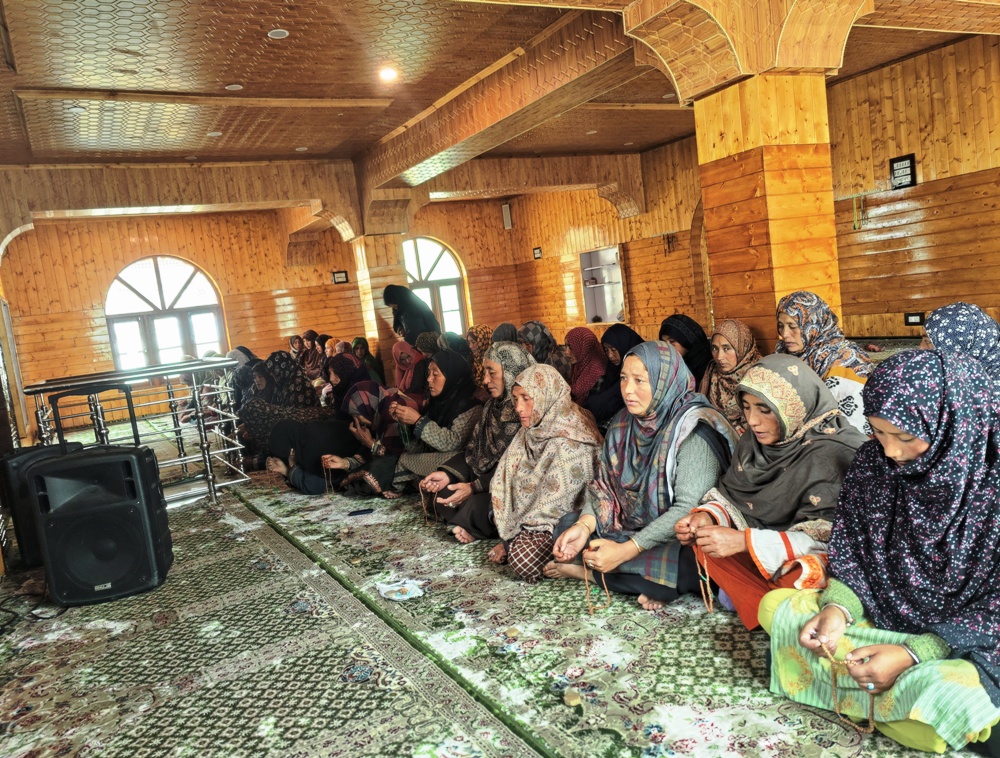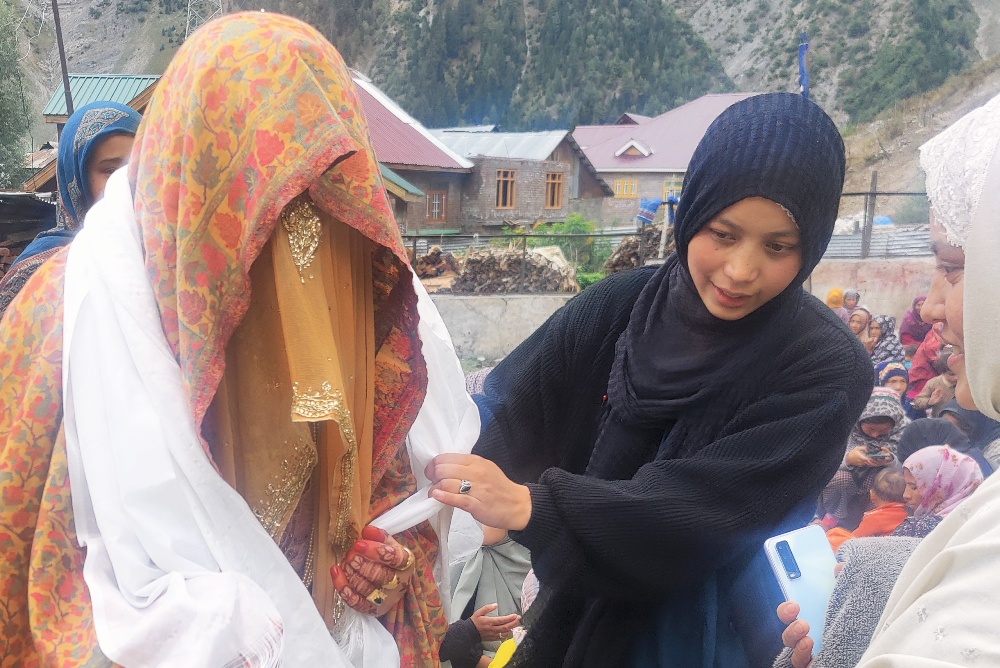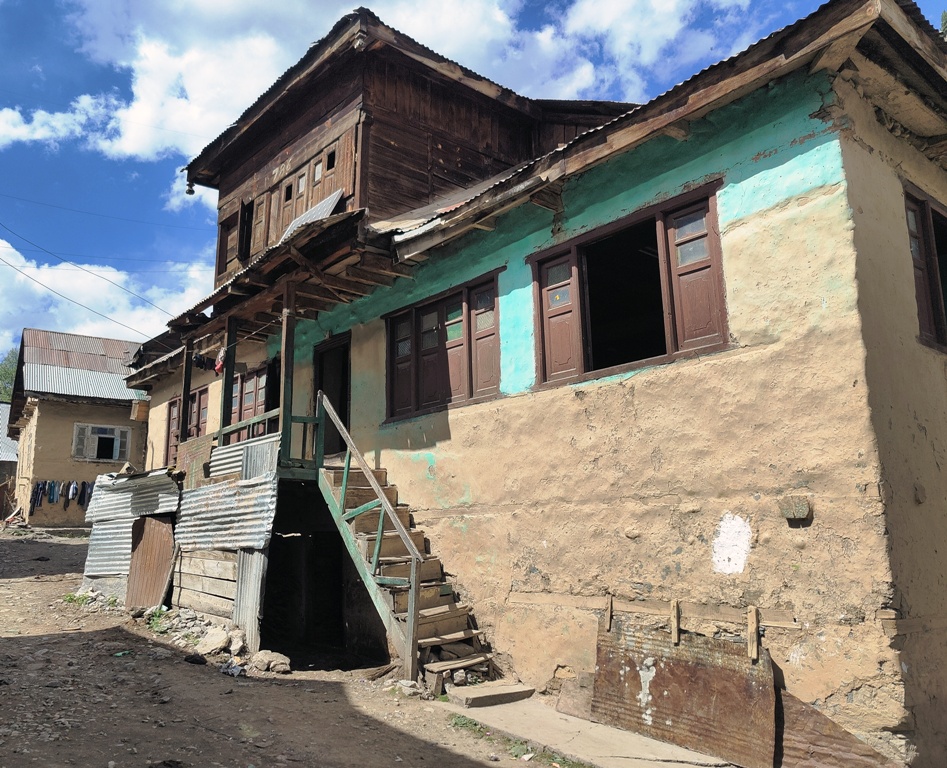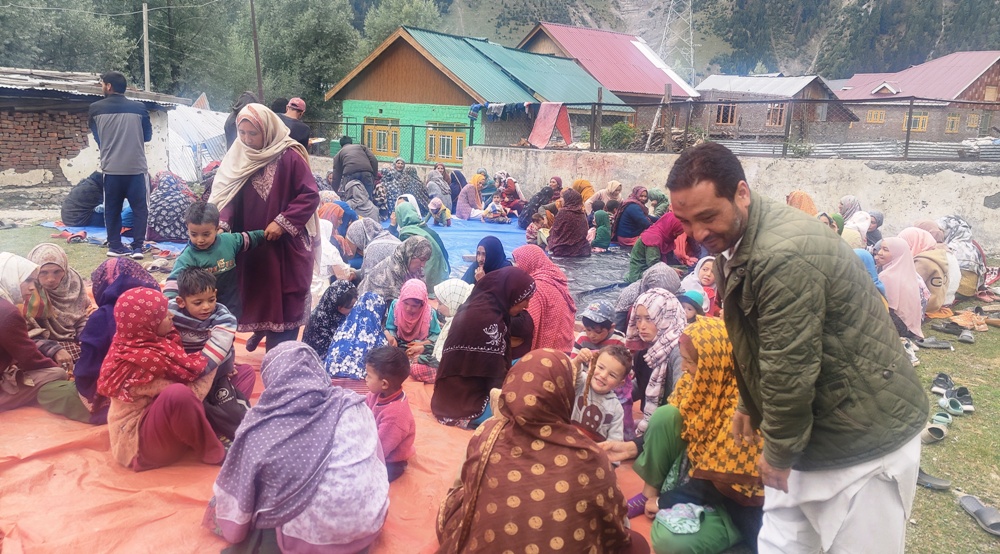The last village on the foothills of Zoji La does not offer a breath-taking view of the Singh Valley alone. It is a model village that can teach too many things to the ‘civilised’ plains, reports Humaira Nabi

The melodious call to prayer echoes gently through the winding alleys of Nilgrar (Neelgrat), a remote mountain hamlet ensconced within the towering peaks of Sonamarg. As the villagers conclude their morning rituals and make their way to the mosque, a profound sense of tranquil community settles over the hamlet.
There exists an abiding sense of serenity and cohesiveness in Nilgrar life, drawn from the natural splendour all around. From the tallest snow-capped peak to the tiniest wildflower – creation and creator are bound as one here. The call of the divine resonates everywhere – in the breeze, birdsong and flowing waters. Faith underpins all aspects of daily existence.
Within these sturdy walls, the villagers unite as one, the soft-hummed prayers of the women from above blending harmoniously with the resonant chants arising from below. In this haven, both the exuberant youth and wizened elderly alike find spiritual nourishment and solace.
Barely four kilometres from the bustle of Sonamarg, yet, somehow untouched by the trappings of modernity, Nilgrar remains a hidden gem nestled between the soaring snow-crested mountains. It is the last village on Srinagar’s historic route to Ladakh on this side of the Zoji La. Surrounded by towering peaks, gushing streams that energise the fertile land, and rolling verdant meadows, this small village is a captivating lush tapestry seldom witnessed by outsiders. Yet beyond just picture-perfect views, Nilgrar’s true beauty lies in the seamless convergence of tradition and progress.
Rooted In Baltistan
The village belongs to the Balti, whose ancestors migrated from Baltistan before 1947, seeking refuge from the volatility that had gripped the region. Historians believe Gilgit-Baltistan underwent frequent shifts in political control during the eighteenth and nineteenth centuries.

As local rulers and external powers alike vied for dominance over the strategic area, instability and conflict plagued the land. Recognising the precarious nature of the region, the peace-loving Balti people journeyed south in search of stability, first settling in Kargil, Himachal before a few families ultimately established the village of Nilgrar. Here they continued their quest for security and better livelihood opportunities. In 1989, the Nilgrar Balti was granted scheduled tribe status in Jammu and Kashmir, opening up professional opportunities in jobs and education for this formerly marginalized community.
The inhabitants of Nilgrar present a unique appearance that reflects both their distant ethnic heritage and their geographic isolation. With typical Central Asian features characterised by small almond-shaped eyes, broad noses and round faces, the villagers stand apart from the general Kashmiri population. However, their clothing and language showcase a blend of both cultures. While the elders speak their native Balti language with accustomed fluency, the younger generations are multilingual, conversing easily in Urdu and Kashmiri as well.
Preserving Identity
In Kargil, the greater Balti population zealously safeguards their cultural heritage against the encroaching tide of assimilation. They employ creative means to keep their traditions alive, producing classical poetry music albums and diligently collecting Balti books brought from Gilgit to maintain a living literary link to their past. Meanwhile in Nilgrar, the local Balti are equally committed to preserving their language, food, values and customs.

“We consciously teach our children Balti first, before Urdu and Kashmiri, recognising the vital role our mother tongue plays in safeguarding our identity, culture
and history,” village teacher, Mohammad Nisar Shabani, said. “While we allow our youth to pursue their passions, we also remain steadfast in instilling within them a deep appreciation for the rich traditions and expressions that define our unique cultural heritage.”
Gender Equality
Despite its limited amenities, the women of Nilgrar stand as exemplars of empowerment who seemingly have risen above the circumstances. Their inclusive status extends beyond just the confines of the village mosque, where they are unreservedly welcome to perform prayers alongside the men. The women here have long been viewed as equal contributors to society, and are encouraged to freely pursue their dreams, aspirations and paths of leadership.
“Our elders took great care to ensure gender inclusivity and equality from the start,” Shabani explained. “We dedicated a prayer space for women as expansive as the men’s hall downstairs. Every household has prioritised formal education for our girls, which to us represents the truest form of empowerment.”
Suriya Bano embodies the spirit of the Nilgrar woman – resolute and ambitious despite limitations. Now in her mid-twenties, Suriya has served as village Sarpanch since 2021. After successfully obtaining her master’s degree, she nurtured a dream of returning home to lead her community toward positive change. Though opportunities were few given the area’s remoteness, Suriya remained undeterred, eventually gaining the village’s unwavering support.
“The absence of local educational institutions forced me and my friends to embark on long journeys to distant cities for schooling,” Suriya recalled her struggle to study. “Throughout those years of hardship, I nourished a dream of one day guiding my village toward growth, development and a brighter future.”
In our village, Suriya said, scarcity of resources has never dampened the aspirations of women seeking more. “The female literacy rate is exemplary and our elders have exemplified that unwavering commitment and determination can overcome any obstacle.”
In Past
The village was described in General Alexander Wardrop’s 1923 book The Guide to Kashmir & Ladakhas as a place of “icy waters” and “craggy summits.” While Sonamarg’s meadows cease at Nilgrar, Wardrop writes that beauty is found in scrambling up the rocky pines and gazing upon the glaciers above. He notes that to fully appreciate the area’s charms, ambitious climbing is a must to view the green slopes, wild glens and snow-capped coloured peaks.

Though secluded, Nilgrar presents captivating vistas of rugged wilderness and quaint village life, encapsulating the essence of unspoiled Kashmir. Perched at the edge of Sonamarg yet isolated in its tranquil valley, Nilgrar remains relatively untouched by modernity – a place Wardrop would surely still deem worthy of appreciation nearly a century later.
Though relatively short in stature, the Balti are known for their incredible physical strength and tireless work ethic. Their way of life revolves around arduous labour, which in turn sustains their livelihoods. Engaging in various physically demanding tasks from sunrise to sundown – be it farming the rugged mountainsides or constructing new homes – the villagers exhibit an unflinching dedication to their responsibilities that shapes the very core of their identity.
Economic Stability
In recent years, the construction of the ambitious Nilgrar tunnels under the strategic Zojila Pass project has provided a significant employment opportunity for the community. Out of Nilgrar’s total population about half are directly engaged in the tunnel initiative, serving as engineers, helpers and technical assistants.
The project encompasses the Nilgrar Tunnel 1 (435 meters), Nilgrar Tunnel 2 (1,950 meters) as well as the crowning centrepiece – the Zojila Tunnel, slated to be Asia’s longest bi-directional tunnel at 13.1 kilometres. Carving through the treacherous pass, the tunnel aims to provide all-weather connectivity between Srinagar, Kargil and Leh.
For many villagers, this tunnel construction work has brought welcome economic stability after years of subsistence living. The younger generation in particular has greatly benefitted, gaining valuable technical skills and hands-on experience with engineering, construction and maintenance.
Twenty-seven-year-old Nilgrar native Mohammad Maisum Balti now serves as a civil engineer on the ambitious tunnel project. “It has been a lifesaver for our community,” he said. “Over the past three years, this opportunity has provided me and others like me with financial independence, while also vastly improving our quality of life.”
Besides, the employment in the tunnel project, the villagers earn substantial supplementary income from leasing 352 Kanals of community land to the Army’s High Altitude Warfare School based nearby. From this arrangement, each household receives around Rs 50-60 thousand annually. They have also donated 100 Kanals of land to security forces as a goodwill gesture.
During the Amarnath Yatra pilgrimage, the villagers are presented with another lucrative opportunity to boost their income. Setting up temporary stalls near the Nilgrar helipad to cater to the needs of weary pilgrims, locals generate substantial revenue during the months-long Yatra period. With thousands of Hindu devotees passing through the remote hamlet en route to the cave shrine, demand for accommodations and refreshments remains high.
“Our village’s proximity to the helipad makes it an ideal location for vendors,” Mohammad Ismail said. “We sell food, beverages, religious items and other essentials required by the pilgrims.”
“Given the influx of devotees during the Yatra, it becomes a profitable venture with each household earning around two to three lakh rupees, each,” claims Nisar.
However, agriculture continues to sustain Nilgrar, as it has for generations prior. Villagers diligently cultivate crops suited for the rugged mountain terrain like potatoes, barley, maize and beans – both for personal consumption and sale at regional markets. Potatoes, which can be stored for months without refrigeration, provide a vital nutritional staple year-round. Barley flour is used to prepare hearty broths and traditional breads.
In the summer months, the villagers climb into the mountains to harvest the prized morel mushroom, known as Gucchi. The rare delicacy grows only at high altitudes in the Himalayas and fetches high prices. Village elders pass down the secret locations where they can be found. It adds to the resident’s income.
While seldom visited by outsiders, those who find this remote mountain hamlet are forever touched by its beauty, wisdom and uncommon calm. And they depart with profound gratitude for this hidden corner of the Himalayas, where culture flows as timelessly as the mountain streams.
Cuisine and Celebrations
During celebrations like weddings, Nilgrar’s womenfolk gather to cook customary Balti bread like Ozuk and Kapchay. Ozuk is sweet fried bread made from eggs, butter, milk and sugar. The dough is rolled thin, cut into square shapes then fried in bubbling oil until golden. Kapchay is a large unleavened fried flatbread that turns delightfully crisp and flaky. Both are served fresh with tea as part of wedding feasts.
Nilgrar weddings reflect the simplicity and communal spirit of village life. Rather than printed invitations, announcements are made at the mosque inviting all to take part in the joyous occasion. With meals served on a trami platter, the cuisine spotlights local vegetarian dishes over non-veg delicacies, keeping with Balti norms.
“Our religious leader sets the Mehr based on what the groom’s family can afford, ensuring a respectful union,” Shabani explained. “His involvement represents our ideals of equity between bride and groom.”
Demographics
Nilgrar is home to about 1,085 people as per the 2011 census. The majority of villagers belong to the Balti community, a scheduled tribe with ethnic roots in Baltistan. Out of Nilgrar’s total population, 683 residents or approximately 63 per cent are Balti.
As per the 2011 census, Overall, the village has 582 males and 503 females, with 227 children aged 0-6 years – about 21% of the population. The child sex ratio is relatively high at 957 girls for every 1,000 boys. However, the adult sex ratio is below the state average at 864 women per 1,000 men.
In terms of literacy, Nilgrar’s overall rate is around 62 per cent as per 2011 data, lower than the average for Jammu and Kashmir. Male literacy stands higher at 73 per cent, while female literacy lags at 48 per cent. Despite limitations, the village boasts nearly universal youth literacy as education is highly valued.
Architecture
The village is located in mountains that witness massive snowfall during winters. Even though the situation of road communication has improved over the decades, reaching the village remains a daunting task. The village offers a grand mix of architecture. There are some homes built in mortar and stone, quite a few in mortar and timber as most of the newer ones follow the modern style using concrete, improved wood and better roofing. There are too many brick homes now. With improved quality of living, most of the households are adorned with well-furnished interiors and beautiful tiles.

However, the residents believe that these strong houses may not withstand the heavy snowfalls. Its location adds to the village’s vulnerability as the region witnesses avalanches almost every season. Besides, they do not wish to remain isolated from the civilisation during the harsh winter months. So, they migrate to Kulan, not far away, and live in peace for the winter.
“As winter descends, the area witnesses a heavy snowfall. For the survival of our livestock, migration becomes a necessity. The preparation for the migration is a communal affair and starts in late autumn, where families come together to assemble their belongings,” Nisar Shabani explained.
While in the past, the migration relied solely on pack animals to carry the burdens, now, with nearly every household having access to vehicles, the migration dynamics have evolved significantly.
Most of the villagers have well-established houses in lower areas of Kullan as well, where they live during winter.
Nurturing Heritage
At the frontier between past and future, the remote village of Nilgrar still tenderly nourishes its roots and traditions. In the vast quiet of the mountains, heritage thrives through a resilient people whose strength and spirit remain unbroken. Though modernity may swiftly be encroaching on their cherished way of life, the Balti walk steadily on a hopeful path towards progress on their terms, keeping their customs alive.
Elders strive to pass down Balti language, cuisine, music and oral history to the young, determined to keep their unique cultural identity intact even as the world changes around them. Village youth are also encouraged to embrace opportunities for education and economic advancement, to build a bridge between the old ways and the new.















